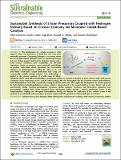Por favor, use este identificador para citar o enlazar a este item:
http://hdl.handle.net/10261/295749COMPARTIR / EXPORTAR:
 SHARE SHARE
 CORE
BASE CORE
BASE
|
|
| Visualizar otros formatos: MARC | Dublin Core | RDF | ORE | MODS | METS | DIDL | DATACITE | |

| Título: | Sustainable Synthesis of Silicon Precursors Coupled with Hydrogen Delivery Based on Circular Economy via Molecular Cobalt-Based Catalysts |
Autor: | Gutiérrez-Tarriño, S.; Rojas-Buzo, Sergio; Ortuño, Manuel A.; Oña-Burgos, Pascual CSIC ORCID | Fecha de publicación: | 8-dic-2022 | Editor: | ACS Publications | Citación: | ACS Sustainable Chemistry and Engineering 10(50): 16624-16633 (2022) | Resumen: | The development of a circular economy is a key target to reduce our dependence on fossil fuels and create more sustainable processes. Concerning hydrogen as an energy vector, the use of liquid organic hydrogen carriers is a promising strategy, but most of them present limitations for hydrogen release, such as harsh reaction conditions, poor recyclability, and low-value byproducts. Herein, we present a novel sustainable methodology to produce value-added silicon precursors and concomitant hydrogen via dehydrogenative coupling by using an air- and water-stable cobalt-based catalyst synthesized from cheap and commercially available starting materials. This methodology is applied to the one-pot synthesis of a wide range of alkoxy-substituted silanes using different hydrosilanes and terminal alkenes as reactants in alcohols as green solvents under mild reaction conditions (room temperature and 0.1 mol % cobalt loading). We also demonstrate that the selectivity toward hydrosilylation/hydroalkoxysilylation can be fully controlled by varying the alcohol/water ratio. This implies the development of a circular approach for hydrosilylation/hydroalkoxysilylation reactions, which is unprecedented in this research field up to date. Kinetic and in situ spectroscopic studies (electron paramagnetic resonance, nuclear magnetic resonance, and electrospray ionization mass spectrometry), together with density functional theory simulations, further provide a detailed mechanistic picture of the dehydrogenative coupling and subsequent hydrosilylation. Finally, we illustrate the application of our catalytic system in the synthesis of an industrially relevant polymer precursor coupled with the production of green hydrogen on demand. copy; 2022 American Chemical Society. | Versión del editor: | http://dx.doi.org/10.1021/acssuschemeng.2c04444 | URI: | http://hdl.handle.net/10261/295749 | DOI: | 10.1021/acssuschemeng.2c04444 | Identificadores: | doi: 10.1021/acssuschemeng.2c04444 issn: 2168-0485 |
| Aparece en las colecciones: | (ITQ) Artículos |
Ficheros en este ítem:
| Fichero | Descripción | Tamaño | Formato | |
|---|---|---|---|---|
| Sustainable_Synthesis.pdf | 3,74 MB | Adobe PDF |  Visualizar/Abrir |
CORE Recommender
Page view(s)
23
checked on 21-may-2024
Download(s)
56
checked on 21-may-2024
Google ScholarTM
Check
Altmetric
Altmetric
Este item está licenciado bajo una Licencia Creative Commons

